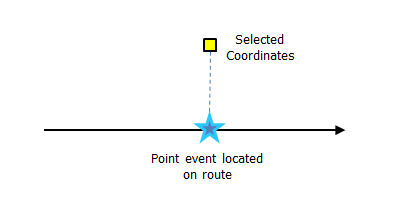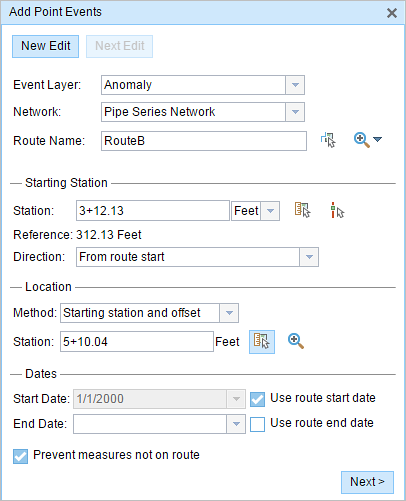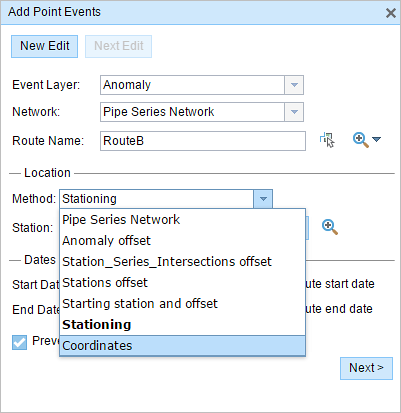Disponible avec la licence Location Referencing.
Point events such as anomalies can be represented as a single point event, with the measure information along the route. The Add Point Events widget allows you to create new point events by typing or selecting its x- and y-coordinates on the map.
Remarque :
If the coordinate location does not fall on the selected route, then a point on the route that is nearest to the coordinate location is chosen to locate the event.
- Open ArcGIS Event Editor and, if prompted, sign in to your ArcGIS organization.
- Click the Edit tab.
- In the Edit Events group, click the Point Events button
 .
.The Add Point Events widget appears.

The widget is unavailable when there are no editable point event layers in the map.
- Click the Event Layer drop-down arrow and choose an event layer to edit.
- Click the Network drop-down arrow and choose the network that will serve as a source for providing the measure for the new event.
- The widget accepts an LRS Network as a source to identify the location for adding the new point event. However, when the new point event data is being stored in the database, the app performs an internal translation of measures to always store the measure value in the linear referencing method (LRM) of the LRS Network with which the event is registered.
- The Network value can be a published LRS Network layer.
- Choose a route name on which the new event measure will be based using any of the following options:
- Type a route name in the Route Name text box.
- Click the Select a Route on the Map tool
 and select the route from the map.
and select the route from the map.
The selected route is highlighted on the map.
- In the Location section, click the Method drop-down arrow and choose the first
option (with the suffix Network).

- Input the x- and y-coordinate values for X and Y, or select a coordinate by clicking the Select an X/Y Location on the Map tool.
If the route ID is specified, the route measure closest to the original coordinates will be selected, and its distance from the route will be displayed.
- Optionally input a value in the GC Factor text box if relevant.
This will adjust the coordinates by dividing x and y by the value specified for GC Factor.
- Select a coordinate system by clicking the Spatial Reference drop-down arrow and choosing an option:
- LRS Spatial Reference—The spatial reference of your LRS Network.
- Web Map Spatial Reference—The spatial reference of your basemap.
- GCS_WGS_1984—A geographic spatial reference using units of degrees.
Additionally, you can configure different coordinate systems by specifying the Well Known ID (WKID) in the configuration file of your ArcGIS Event Editor.
Learn more about configuring the ArcGIS Event Editor web app
- A yellow square is shown at the x,y coordinate location if Show XY Location is checked.
- A red x is shown on the route at the location of the point event.
- Choose the date that will define the start date of the events by doing one of the following:
- Type the start date in the Start Date text box.
- Click the Start Date drop-down arrow and choose the start date.
- Check the Use route start date check box.
The start date defaults to today's date, but you can choose a different date using the date picker.
Remarque :
If you configured your Event Editor instance to not allow dates before the start date of the route, and you provide a date before the start date of the selected route in Start Date, a warning message appears alerting you to choose a date on or after the start date of the selected route.
- Choose the date that will define the end date of the events by doing one of the following:
- Type the end date in the End Date text box.
- Click the End Date drop-down arrow and choose the end date.
- Check the Use route end date check box.
The end date is optional, and if it is not provided, the event remains valid now and into the future.
- The Prevent measures not on route check box is checked by default.
Prevent measures not on route—This data validation option ensures that the input measure values for the start and end measures fall in the minimum and maximum range of measure values on the selected route.
- Click Next to view the Attribute Value table.
This table contains all the attributes of the event layer.
- Provide attribute information for the new event in the table.
Conseil :
You can click the Copy Attribute Values button
 and click an existing point event belonging to the same event layer on the map to copy event attributes from that point.
and click an existing point event belonging to the same event layer on the map to copy event attributes from that point. - Check the Show network name check box to show the LRS Network with which the selected event layer is associated.
- Click Save.
A confirmation message appears at the lower right once the newly added point event is saved. The new point is created and appears on the map.
After a point event has been successfully created, you have the following two options to continue characterizing the route:
- Click New Edit to clear all the input entries in the widget and restore the default values from the geodatabase to the table.
- Click Next Edit to retain all the existing entries in the widget and the attribute set for convenience and for quick editing of similar characteristics.
Vous avez un commentaire à formuler concernant cette rubrique ?